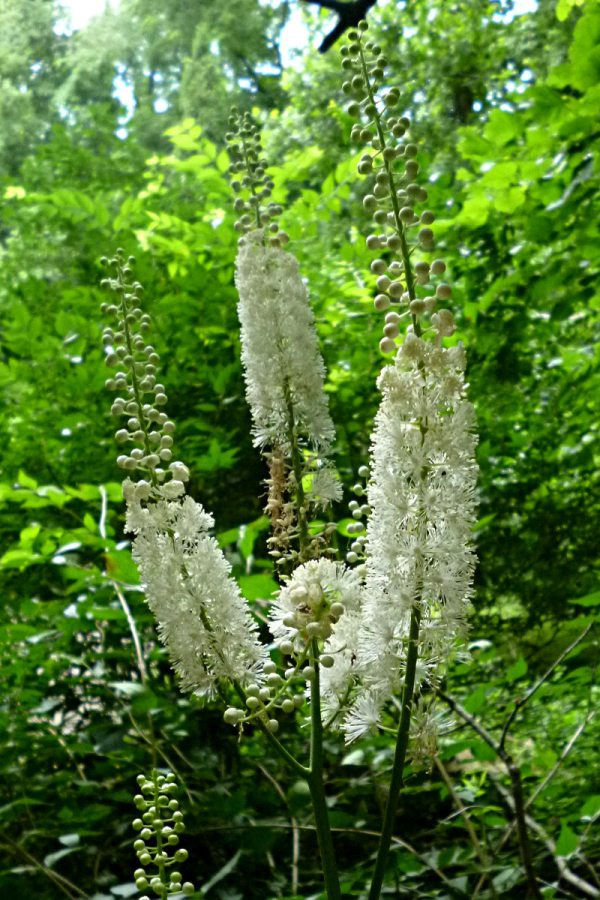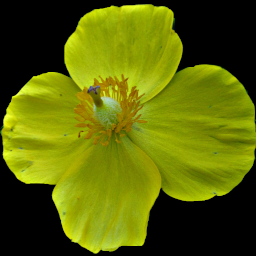 Also known as Fairy Candles for the way it lights up the deep shade of the woods, or as Black Snakeroot, or Bugbane, and more commonly placed in the genus Cimicifuga until recently. It can tolerate a very shady location, and often grows in thick woods. This plant was one of a small colony growing on a thickly wooded hillside in Mount Lebanon, where it was blooming in early July. Another picture of the same plant, but in a different year, is here.
Also known as Fairy Candles for the way it lights up the deep shade of the woods, or as Black Snakeroot, or Bugbane, and more commonly placed in the genus Cimicifuga until recently. It can tolerate a very shady location, and often grows in thick woods. This plant was one of a small colony growing on a thickly wooded hillside in Mount Lebanon, where it was blooming in early July. Another picture of the same plant, but in a different year, is here.
Flowers. Tiny, white, in forked racemes 3 or more feet (a meter) tall, occasionally up to 9 feet (3 meters); the stamens are the most visible part.
Leaves. Large, smooth, in whorls of 3, each doubly compound leaf made of three leaflets which themselves are subdivided in three or five leaflets; the leaflets irregularly and jaggedly toothed, the terminal leaflet usually 3-lobed.
Stems. Smooth, with enlarged purplish joints where the leaves are joined; some whitish bloom on the lower part.
Gray describes the genus Cimicifuga and the species, which he places in the Macrotrys subgenus:
CIMICÍFUGA L. BUGBANE. Sepals 4 or 5, failing off soon after the flower expands. Petals, or rather transformed stamens, 1-8, small, on claws, 2-horned at the apex. Stamens as in Actaea. Pistils 1-8, forming dry dehiscent pods in fruit. — Perennials, with 2-3-ternately divided leaves, the leaflets cut-serrate, and white flowers in elongated wand-like racemes. (Name from cimex, a bug, and fugere, to drive away.)
MACRÒTRYS (Raf.) T. & G. (as Macrotys). Pistil solitary or sometimes 2-3, sessile; seeds smooth, flattened and packed horizontally in the pod in two rows, as in Actaea; stigma broad and flat.
C. racemòsa (L.) Nutt. (BLACK SNAKEROOT, BLACK COHOSH.) Stem 1-2.0 rn. high, from a thick knotted rootstock; leaves 2-3-ternately and then often quinately compound; leaflets subcuneate to subcordate at the base; racemes in fruit becoming 3-9 dm. long; pods ovoid. — Rich woods, s. N. E. to Wise, and southw.; cultivated and escaped eastw. July.
[Because modern botanists have moved this species over to the genus Actaea, we give Gray’s description of that genus as well:
ACTAÈA L. BANEBERRY, COHOSH. Sepals 4 or 6, falling off when the flower expands. Petals 4-10, small, flat, spatulate, on slender claws. Stamens numerous, with slender white filaments. Pistil single; stigma sessile, depressed, 2-lobed. Seeds smooth, flattened, and packed horizontally in 2 rows. — Perennials, with ample 2-3-ternately compound leaves, the ovate leaflets sharply cleft and toothed, and a short and thick terminal raceme of white flowers. (From aktea, actaea, ancient names of the Elder, transferred by Linnaeus.)]

One response to “Black Cohosh (Actaea racemosa)”
[…] close relative of Black Cohosh (Actaea racemosa), this plant has smaller round tufts of white flowers. But its most striking feature is these […]